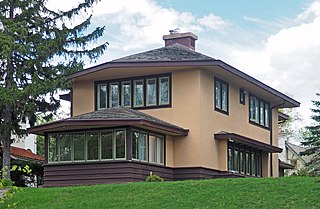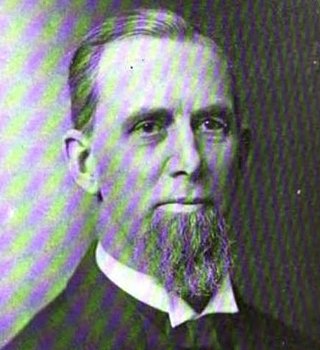Related Research Articles

Hancock is a city in the Upper Peninsula of the U.S. state of Michigan. The population of Hancock was 4,501 at the 2020 census. The city is located within Houghton County, and is situated upon the Keweenaw Waterway, a channel of Lake Superior that cuts across the Keweenaw Peninsula. Hancock is located across the Keweenaw Waterway from the city of Houghton, and is connected to that city by the Portage Lake Lift Bridge. The city is located within Michigan's Copper Country region.

Calumet is a village in the Upper Peninsula of the U.S. state of Michigan. The village is located within Calumet Township, Houghton County, and had a population of 621 at the 2020 census.

Maxime Du Camp was a French writer and photographer.

Prairie School is a late 19th- and early 20th-century architectural style, most common in the Midwestern United States. The style is usually marked by horizontal lines, flat or hipped roofs with broad overhanging eaves, windows grouped in horizontal bands, integration with the landscape, solid construction, craftsmanship, and discipline in the use of ornament. Horizontal lines were thought to evoke and relate to the wide, flat, treeless expanses of America's native prairie landscape.
William Gray Purcell was a Prairie School architect in the Midwestern United States. He partnered with George Grant Elmslie, and briefly with George Feick. The firm of Purcell & Elmslie produced designs for buildings in twenty-two states, Australia, and China. The firm had offices in Minneapolis, Minnesota; Chicago, Illinois; Philadelphia, Pennsylvania; and Portland, Oregon.
George Grant Elmslie was an American Prairie School architect whose works are is mostly found in the Midwestern United States. He worked with Louis Sullivan and later with William Gray Purcell as a partner in the firm Purcell & Elmslie.
Scotch-IrishAmericans are American descendants of Ulster Protestants who emigrated from Ulster to America during the 18th and 19th centuries. Their ancestors had originally migrated to Ulster mainly from the Scottish Lowlands and Northern England in the 17th century. In the 2017 American Community Survey, 5.39 million reported Scottish ancestry, an additional 3 million identified more specifically with Scotch-Irish ancestry, and many people who claim "American ancestry" may actually be of Scotch-Irish ancestry.

Scotch College is a private, Presbyterian day and boarding school for boys, located in Hawthorn, an inner-eastern suburb of Melbourne, Victoria, Australia.

William LaBarthe Steele was an American architect from Chicago, Illinois. He is considered a principal member of the Prairie School Architectural Movement during the early 20th century.

Fort Wilkins Historic State Park is a historical park operated by the Michigan Department of Natural Resources at Copper Harbor, Michigan. The park preserves the restored 1844 army military outpost, Fort Wilkins, which was placed on the National Register of Historic Places in 1970. The state park's 700 acres (280 ha) include camping and day-use facilities as well as the Copper Harbor Lighthouse, built in 1866. The park is a "Cooperating Site" of the Keweenaw National Historical Park.
Purcell & Elmslie (P&E) was the most widely know iteration of a progressive American architectural practice. P&E was the second most commissioned firm of the Prairie School, after Frank Lloyd Wright. The firm in all iterations was active from 1907 to 1921, with their most famous work being done between 1913 and 1921.

The First National Bank of Mankato, also known as the Old First National Bank of Mankato and located at 229 South Front Street in Mankato, Minnesota, United States, is a fine example of Prairie School architecture in a commercial building, relating rural life to the development of downtown Mankato as a regional center of commerce and finance. The recently restored exterior is now part of the Mankato Civic Center, the Mayo Clinic Health System Event Center.

Harold C. Bradley House, also known as Mrs. Josephine Crane Bradley Residence, is a Prairie School home designed by Louis H. Sullivan and George Grant Elmslie. It is located in the University Heights Historic District of Madison, Wisconsin, United States. A National Historic Landmark, it is one of just a few residential designs by Sullivan, and one of only two Sullivan designs in Wisconsin.

Stanley Spencer Reid was an Australian rules footballer with the Fitzroy Football Club from 1894 to 1898.

The Dr. Oscar Owre House is a historic house located at 2625 Newton Venue South just north of Lake of the Isles in Minneapolis, Minnesota. It was designed by notable local architects Purcell, Feick & Elmslie in the Prairie School style.

The E.S. Hoyt House is a historic house in Red Wing, Minnesota, United States, designed by the firm of Purcell & Elmslie and built in 1913. The house is listed on the National Register of Historic Places. It is also a contributing property to the Red Wing Residential Historic District.

Theodore Ledyard Cuyler was an American Presbyterian minister and writer.

William DeWitt Alexander was an educator, author and linguist in the Kingdom of Hawaii and Republic of Hawaii. He then constructed maps for the Territory of Hawaii.

The McKinley Town Hall is a historic Prairie School building located in Jump River, Wisconsin. Built in 1915, it was designed by the noted Prairie School architects Purcell & Elmslie, and is significant as the smallest public building they designed. It was listed on the National Register of Historic Places in 1974.

Willard Harris Chandler was an American educator, farmer, and Republican politician. He served in the Wisconsin State Senate and Assembly, and was President pro tempore of the Wisconsin Senate for the 1865 and 1866 sessions.
References
- ↑ "DEATH LIST OF A DAY.; William C. Gray". The New York Times. September 30, 1901 – via NYTimes.com.
- 1 2 Purcell, William Gray (January 1967). St. Croix Trail Country: Recollections of Wisconsin. U of Minnesota Press. ISBN 9780816658541.
- ↑ "The Christian Advocate". 1902.
- 1 2 3 "Purcell and Elmslie, Architects". organica.org.
- ↑ "The Scotch-Irish in America: Proceedings of the Scotch-Irish Congress". 1900.
- ↑ WHITE, W. P. (1919). "The Evolution of a Presbyterian Religious Journal". Journal of the Presbyterian Historical Society (1901-1930). 10 (1): 36–41. JSTOR 23323279 – via JSTOR.
- ↑ Carter, Heath W. (2015). Union Made: Working People and the Rise of Social Christianity in Chicago. Oxford University Press. ISBN 978-0-19-938595-9.
- ↑ Legler, Dixie; Guerrero, Dixie Legler (5 October 2006). At Home on the Prairie: The Houses of Purcell & Elmslie. Chronicle Books. ISBN 9780811850414.
- 1 2 Gray, William (5 July 2011). Keweenaw: An Early Story of the Copper Country - the Original 1884 Text. CreateSpace Independent Publishing Platform. ISBN 9781463688097.
- ↑ "Gray, William Cunningham, 1830-1901 | The Online Books Page". onlinebooks.library.upenn.edu.
- ↑ Gray, William Cunningham (1902). "Musings by Camp-fire and Wayside".
- ↑ "Presbyterian Banner". 1902.